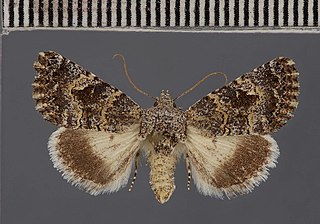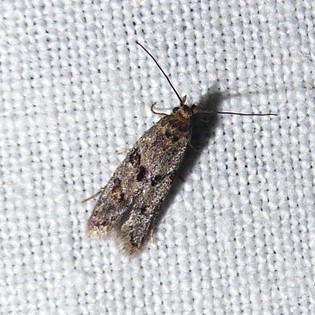
The Canary Islands, also known informally as the Canaries, are a Spanish region, autonomous community and archipelago in the Atlantic Ocean. At their closest point to the African mainland, they are 100 kilometres west of Morocco and the Western Sahara. They are the southernmost of the autonomous communities of Spain. The islands have a population of 2.2 million people and are the most populous special territory of the European Union.

Hypericum canariense is a species of flowering plant in the family Hypericaceae known by the common name Canary Islands St. John's wort. It is the sole member of Hypericumsect. Webbia.

Metopoceras kneuckeri is a moth of the family Noctuidae first described by Hans Rebel in 1903. It is found in northwest Africa, Pakistan, and the United Arab Emirates.

Jardín Botánico Canario Viera y Clavijo is the full name of the botanical garden on Gran Canaria, one of the Canary Islands. "Jardín Botánico Canario" means "Botanical Garden of the Canaries", while the additional words "Viera y Clavijo" honor the pioneering Spanish cleric and scholar José Viera y Clavijo (1731–1813), who attempted to found a botanical garden in the Canary Islands in the late eighteenth century.

Dichomeridinae is a subfamily of moths in the family Gelechiidae.

Chersogenes canariensis is a species of moth in the family Autostichidae. It is found on the Canary Islands.

Chersogenes victimella is a species of moth in the family Autostichidae. It is found on the Canary Islands.

Chersogenes brachyptera is a species of moth in the family Symmocidae. It is found on the Canary Islands.
Chersogenes klimeschi is a species of moth in the family Symmocidae. It is found on the Canary Islands.
Apatema junnilaineni is a moth of the family Autostichidae. It is found on the Canary Islands.
Apatema mediopallidum is a moth of the family Autostichidae. It is found on Corsica, Sardinia, Sicily, Malta, Crete, Cyprus and in Portugal, Spain, France, Italy, Austria, Hungary, Albania, the Czech Republic, Romania, Bulgaria, North Macedonia, Greece, Turkey and on the Canary Islands.

Apatema coarctella is a moth of the family Autostichidae. It is found on the Canary Islands and Madeira.
Chersogenes eupracta is a species of moth in the family Autostichidae. It is found on the Canary Islands.
Spinipogon virginanus is a species of moth of the family Tortricidae. It is found on the British Virgin Islands.

Drasteria philippina is a moth of the family Erebidae. It is found on the Canary Islands, as well as in Morocco, Algeria, Libya, Egypt, Israel and Malta.

Chersogenes is a genus of moths in the family Autostichidae.
Chersogenes arenbergerorum is a species of moth in the family Autostichidae. It was described by László Anthony Gozmány in 1988. It is found in Tunisia.
Chersogenes enigmatica is a species of moth in the family Autostichidae. It was described by László Anthony Gozmány in 1964. It is found in Algeria.
Chersogenes friedeli is a species of moth in the family Autostichidae. It was described by László Anthony Gozmány in 1988. It is found in Morocco.
Chersogenes tunesica is a species of moth in the family Autostichidae. It was described by László Anthony Gozmány in 1988. It is found in Tunisia.











